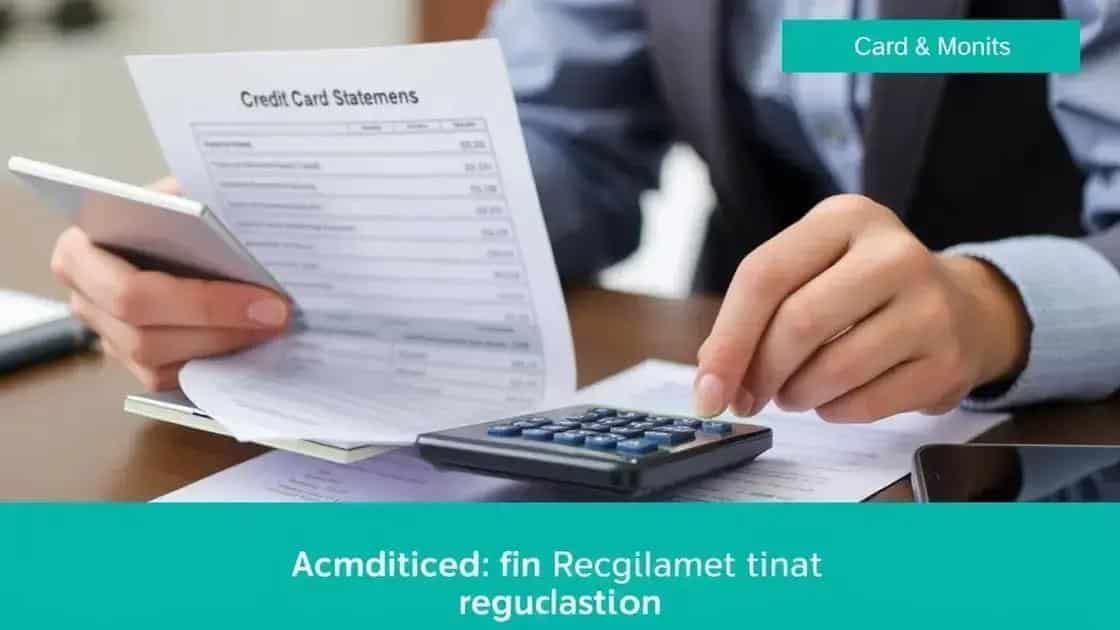2025 regulations cap credit card late fees

Anúncios
The 2025 regulations cap credit card late fees, providing consumers with lower penalties, increased transparency, and better financial management opportunities.
2025 regulations cap credit card late fees, bringing significant changes to how fees are managed in the credit industry. Curious about what this means for you?
Anúncios
Details of the 2025 credit card regulations
The 2025 credit card regulations mark a significant shift in how late fees are managed, ensuring better protections for consumers. Understanding these details is crucial for anyone using credit cards.
Key Aspects of the New Regulations
The core aim of these regulations is to promote fairness in billing practices. By capping late fees, consumers will see a reduction in unexpected charges, which can significantly impact their finances.
Anúncios
- Late fees will be limited to a specific dollar amount.
- Changes aim to improve transparency in billing.
- Financial institutions must clearly communicate new fee structures.
Furthermore, the regulations also mandate that card issuers provide educational resources to help consumers understand their financial responsibilities. This means consumers can expect more guidance on managing their credit effectively.
Consumer Protection Measures
With these new rules, protections against abusive practices are also a priority. Consumers will benefit from clearer communication and fair treatment from credit card companies. This can lead to a more positive experience for cardholders, as both awareness and education are emphasized.
The shift in policies indicates a transition towards prioritizing the consumer experience. As a result, individuals can have greater peace of mind knowing that their financial well-being is being safeguarded.
Overall, the 2025 regulations represent a crucial step toward improving the landscape of credit card usage. By capping late fees and enhancing consumer protections, these changes aim to foster a more equitable financial environment.
Impact on consumers and creditors

The impact on consumers and creditors as a result of the 2025 credit card regulations is profound and multi-faceted. These new rules are designed to offer better protection for consumers while also affecting how creditors operate.
Positive Effects for Consumers
One of the most noticeable changes will be the reduction of late fees. Consumers can now expect more manageable charges when they miss a payment deadline. This helps in avoiding overwhelming debt, which is a significant relief for many cardholders.
- Lower late fees lead to improved financial health.
- Greater clarity on potential charges enhances budgeting.
- More education resources from creditors may increase financial literacy.
Additionally, with clearer terms and conditions, consumers become more informed about what to expect. This transparency fosters trust, encouraging responsible use of credit cards.
Effects on Creditors
On the creditor side, while these regulations may result in reduced revenue from late fees, they also encourage lenders to adopt better practices. By providing educational resources, creditors not only comply with the regulations but also build stronger relationships with their customers.
The emphasis on fair treatment offers a unique opportunity for creditors to differentiate themselves in a competitive market. They can focus on customer service and support rather than relying solely on fees for income.
As consumers become more aware of their rights and understand their financial options, the dynamics in the credit card industry will likely shift. This evolving landscape is beneficial for responsible lending and borrowing.
Ways consumers can benefit from the cap
Consumers stand to gain significantly from the new rules regarding late fees. The cap on credit card late fees serves as a protective measure that can lead to better financial management.
Financial Relief
One of the primary benefits is the financial relief provided by lower late fees. Instead of facing high penalties for missed payments, consumers can now manage their finances more effectively.
- Reduced late fees help prevent debt from spiraling out of control.
- Lower financial penalties can improve overall budgeting and savings efforts.
- Encourages timely payments without excessive punishment.
This shift promotes a sense of security among consumers who may have previously been anxious about incurring large fees.
Increased Transparency
Another benefit of the cap is increased transparency in billing practices. Consumers will receive clearer information regarding potential charges, which allows them to make better-informed decisions. Knowing exactly what to expect can reduce confusion.
As creditors must clearly lay out the new fee structures, this fosters a more trustworthy relationship. With less hidden fees or sudden charges, consumers can focus more on using their credit responsibly.
The cap on late fees also enables consumers to seek out credit cards that align with their financial goals. They can compare options based on fees and choose a card that fits their needs best.
Enhanced Educational Resources
With the regulations, creditors are also required to provide more educational resources. These resources can guide consumers in understanding their rights and responsibilities, helping them make informed choices about credit.
- Workshops about managing credit effectively can be beneficial.
- Information on avoiding common pitfalls can enhance financial literacy.
- Access to financial planning tools can assist budgeting.
Ultimately, the cap on late fees not only eases the financial burden but also empowers consumers to take control of their credit journeys.
Potential challenges and considerations

The potential challenges and considerations arising from the new 2025 credit card regulations are important for both consumers and creditors. Understanding these challenges can help individuals navigate the evolving landscape of credit.
Consumer Adaptation
One significant challenge for consumers is adapting to the new fee structures. While lower late fees are beneficial, some consumers may still struggle with payment deadlines.
- It is crucial for consumers to stay organized and keep track of their payment dates.
- Failure to adapt could result in continued debt accumulation.
- Some may find it difficult to change their existing financial habits.
The educational resources provided by creditors will play a vital role here. If consumers engage with these resources, they can overcome these obstacles and improve their financial management skills.
Impact on Creditors
Creditors also face challenges in adapting to these regulations. They need to adjust their business models to account for reduced income from late fees. This may require more focus on customer service and responsible lending practices.
As the regulations encourage ethical behavior in the credit industry, creditors must ensure they are not only compliant but also competitive. This shift may involve investing in technology and training to better serve their customers.
Market Reactions
Market reactions can also present challenges following these changes. There could be competitive pressures as creditors seek to differentiate themselves in terms of fees and services.
- Some creditors may resort to increasing other fees to compensate.
- This can lead to confusion and potential dissatisfaction among consumers.
- Monitoring market changes will be essential to identify emerging challenges.
In navigating these challenges, both consumers and creditors will need to remain informed and adaptable. Open communication is vital for successfully implementing the new regulations and creating a healthier credit environment.
FAQ – Questions about the 2025 Credit Card Regulations
What is the main change in the 2025 credit card regulations?
The main change is the cap on late fees, which limits how much consumers can be charged for missed payments.
How do the new regulations benefit consumers?
Consumers benefit through lower late fees, increased transparency in billing, and access to educational resources that improve financial literacy.
What challenges might consumers face with the new regulations?
Consumers may struggle to adapt to the new fee structures and need to stay organized to avoid missed payments.
How will creditors be impacted by these new rules?
Creditors will need to adjust their business models to account for reduced income from late fees and focus more on customer service.






